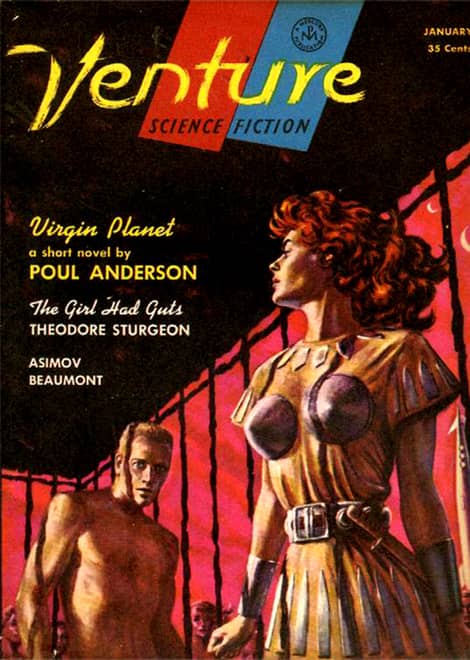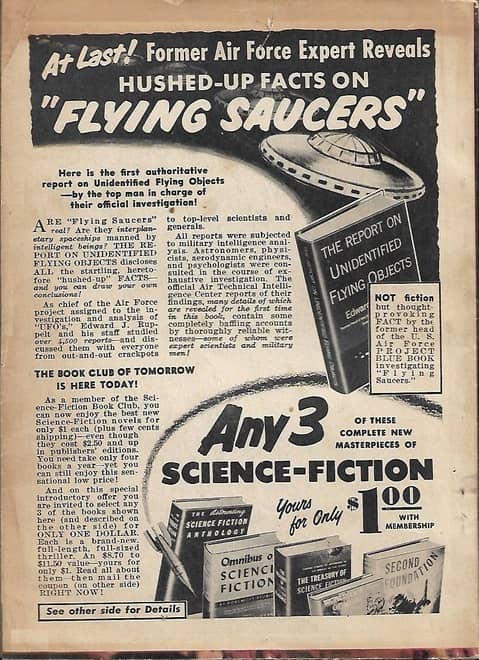Birthday Reviews: Theodore Sturgeon’s “The Girl Had Guts”
 |
 |
Cover by Ed Emshwiller
Theodore Sturgeon was born on February 26, 1918 (Happy Centennial Theodore!) and died on May 8, 1985. Sturgeon won the Hugo and Nebula Awards for his story “Slow Sculpture,” possibly the only time a story has won the Novelette Nebula and the Short Story Hugo.
His novel More Than Human received the International Fantasy Award. A translation of “And Now the News…” received a Seiun Award while “The World Well Lost” received a Gaylactic Spectrum Hall of Fame Award. Sturgeon himself received the Forry Award from LASFS in 1971 and a Life Achievement World Fantasy Award shortly after his death. In 2000 he was inducted into the Science Fiction Hall of Fame. He’s remembered today mostly for his short stories, including “Killdozer,” “A Saucer of Loneliness,” and “If All Men Were Brothers, Would You Let One Marry Your Sister,” but he also wrote the novels More Than Human, Venus Plus X, and The Dreaming Jewels. Kurt Vonnegut’s recurring character Kilgore Trout is believed to have been named for him.
Sturgeon wrote the classic Star Trek episode “Amok Time,” which introduced the Vulcan salute and the phrase “Live long and prosper.” His short fiction has been collected into a thirteen volume set by North Atlantic Press. The Theodore Sturgeon Memorial Award, presented annually for short stories by the Gunn Center at the University of Kansas, is named in his honor.
“The Girl Had Guts” was purchased by Robert P. Mills for Venture Science Fiction magazine and ran in the January 1957 issue. Sturgeon later included it in his collection A Touch of Strange and it was translated into French for inclusion in Fiction #109 and into Italian for Profumo d’infinito. It was again published in French in 1984 in Histoires de creatures and a fresh translation was done in 2005 for its appearance in Romans et nouvelles. The story appeared in And Now the News…, volume 9 of the complete stories of Theodore Sturgeon series, and was reprinted in the June 2, 2004 issue of Sci Fiction. Mike Ashley picked up the story for The Mammoth Book of Extreme Science Fiction.
Sturgeon uses a framing technique for “The Girl Had Guts.” Captain Gargan has returned home to his wife after a mission to another planet, followed by six weeks in quarantine. Although there seems to be no reasons for this set up as Sturgeon relates the story of the mission through Gargan, eventually the reason for the structure becomes clear.
Gargan’s crew’s landing on the planet was not what they expected. They discovered three of the preliminary exploration team dead, one catatonic, and the final one with a strange disease. By going through their records, Gargan is able to tell his wife what has happened to them.
The story was written in the 1950s and, despite having three competent female scientists on the exploratory team and only two males, the gender politics of the story are extremely dated. Amy Segal, the key to the story, becomes a simpering wreck when a man brushes by her and she develops a school girl crush. Nevertheless, Sturgeon tries to depict her as the strongest member of the initial crew.
By the time Gargan tells his wife what happened to the original team, most of their experiences have been resolved, so there is a distance between the reader and the action which tends to weaken its impact.
Reprint reviewed in the collection And Now the News…: Volume IX: The Complete Stories of Theodore Sturgeon, edited by Paul Williams, North Atlantic Books, 2003.
 Steven H Silver is a fifteen-time Hugo Award nominee and was the publisher of the Hugo-nominated fanzine Argentus as well as the editor and publisher of ISFiC Press for 8 years. He has also edited books for DAW and NESFA Press. He began publishing short fiction in 2008 and his most recently published story is “Big White Men—Attack!” in Little Green Men—Attack! Steven has chaired the first Midwest Construction, Windycon three times, and the SFWA Nebula Conference 5 times, as well as serving as the Event Coordinator for SFWA. He was programming chair for Chicon 2000 and Vice Chair of Chicon 7. He has been the news editor for SF Site since 2002.
Steven H Silver is a fifteen-time Hugo Award nominee and was the publisher of the Hugo-nominated fanzine Argentus as well as the editor and publisher of ISFiC Press for 8 years. He has also edited books for DAW and NESFA Press. He began publishing short fiction in 2008 and his most recently published story is “Big White Men—Attack!” in Little Green Men—Attack! Steven has chaired the first Midwest Construction, Windycon three times, and the SFWA Nebula Conference 5 times, as well as serving as the Event Coordinator for SFWA. He was programming chair for Chicon 2000 and Vice Chair of Chicon 7. He has been the news editor for SF Site since 2002.
A worthy list of achievements, but probably the one that will last the longest is his formulation of Sturgeon’s Law: “Ninety percent of everything is crap.” (Or “crud”, depending on who tells it.)
Neat as Sturgeon’s Law is, I sincerely hope achievements like “The Saucer of Loneliness”, “… And Now the News”, and “The Man Who Lost the Sea” last at least as long!
Venture was at that time trying to be sexually adventurous (see VIRGIN PLANET, the cover story, for an example of what that meant in the SF of the ’50s), which may explain some of the gender politics in the story.
I remember how disappointed I was as a collector to find that VENTURE lasted only 10 issues. It had a stellar list of contributors, and the covers by EMSH were spectacular.
Speaking of Sturgeon’s Law…. I just saw on Wikipedia that this Law was first expressed in the March 1958 issue of Venture!
https://en.wikipedia.org/wiki/Sturgeon%27s_law
Only 10 issues? That’s too bad…but according to Sturgeon, nine of them aren’t worth having anyway!
Venture was revived in 1969/70 for an additional six issues. Ed Ferman edited them instead of Robert Mills, but they were also published by Mercury (which published the last two issues of the original run). The 69 run was considered volume 3, building on the earlier run.
> Only 10 issues? That’s too bad…but according to Sturgeon, nine of them aren’t worth having anyway!
Thomas,
OK, that made me snort water all over my keyboard….
Had never heard of Venture until now. Big name (Sturgeon) for the birthday review. Thanks Steven.
This is off-topic, but maybe someone can help. There’s a lot of expertise here.
An elderly friend of mine seems to remember reading a review of E. R. Eddison’s THE WORM OUROBOROS as by Theodore Sturgeon. This would have been in the mid- to late 1950s, possibly early 1960s, but definitely before Ballantine released its paperback of the Eddison around 1967. The review might have referred to a hardcover edition or possibly to the “Xanadu Library” paperback. The review probably appeared in one of the genre magazines rather than in a fanzine. So far I haven’t been able to trace this. I’d be delighted if someone could locate it. If it would be fun to peruse your shelves of old sf pulps… please do!
Hi Dale,
Great question. It doesn’t ring any bells for me, and ISFDB lists two dozen or so magazine reviews of THE WORM OUROBOROS, but nothing that looks like it was written by Theodore Sturgeon. Hopefully someone else has a clue?
https://www.isfdb.org/cgi-bin/title.cgi?781